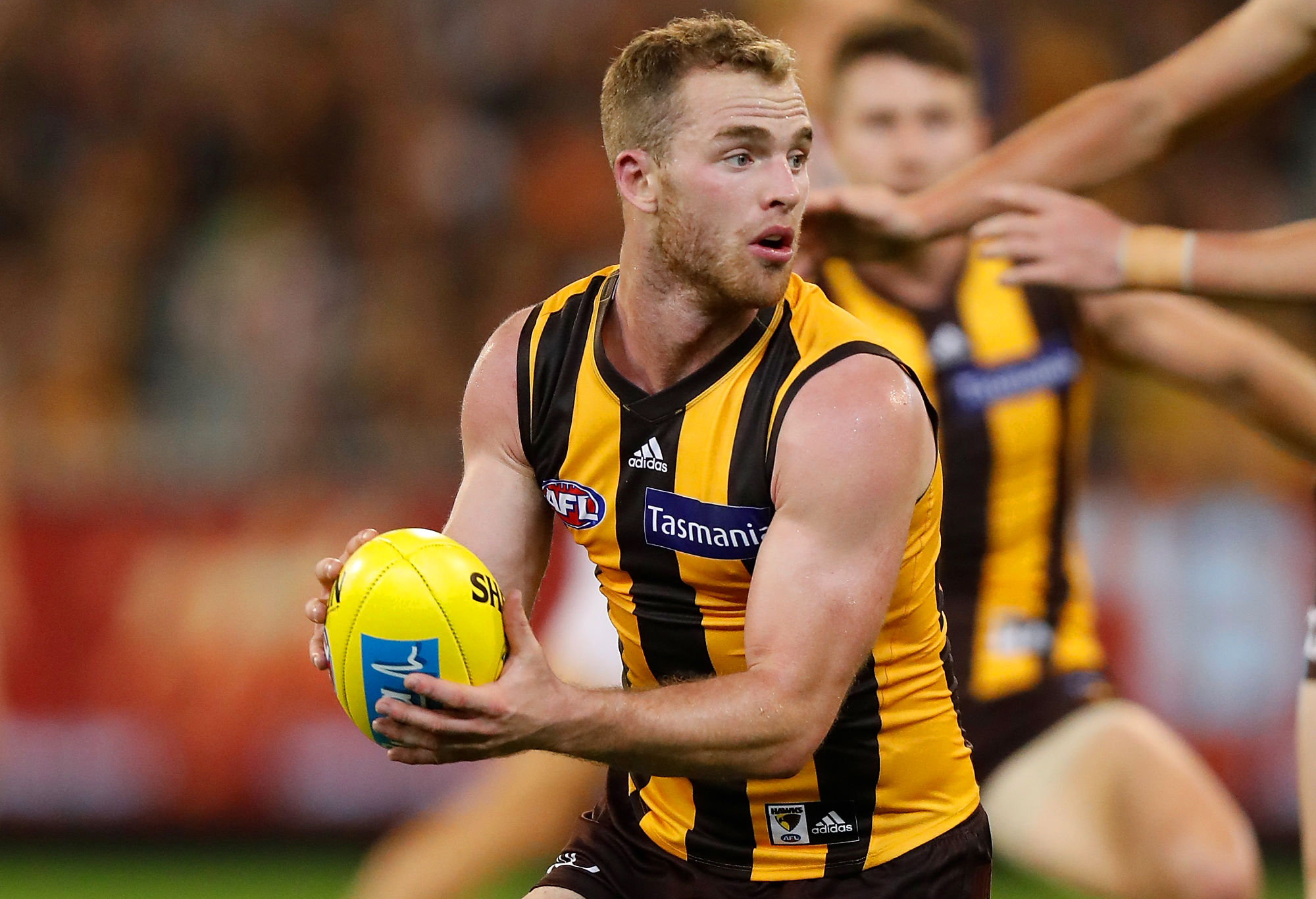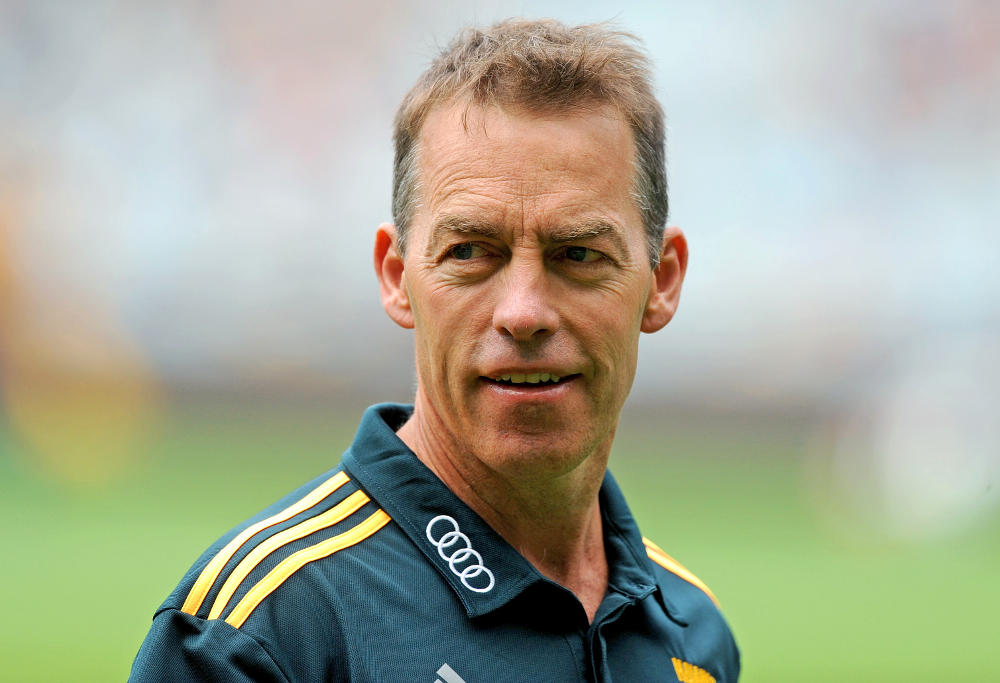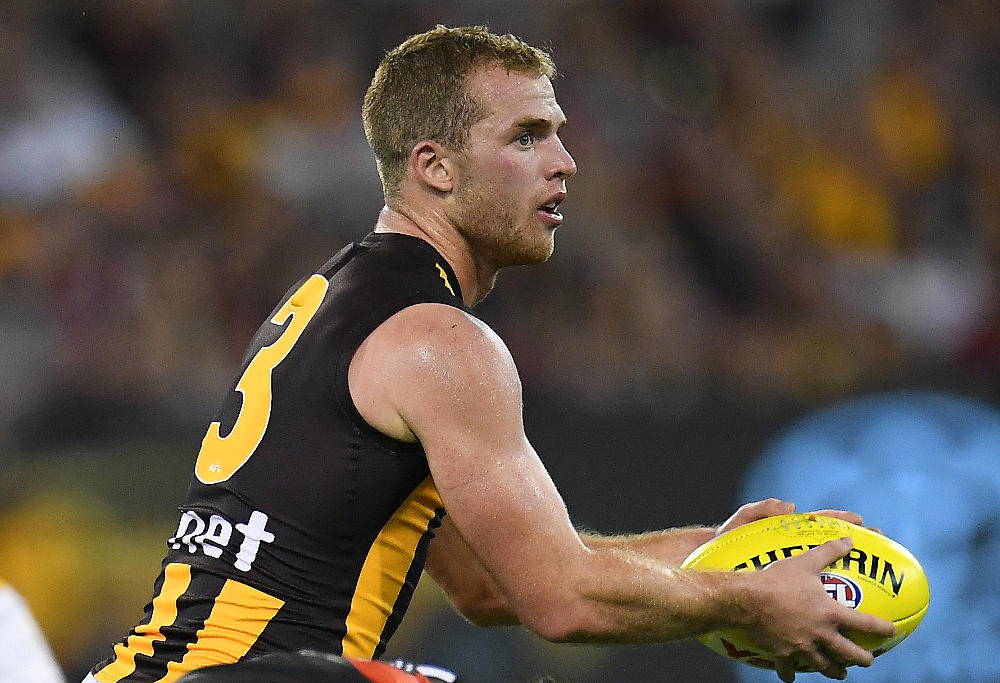Four rounds into the season, and one team in particular has obliterated preseason expectations.
Hawthorn is back, earlier than even the most optimistic Hawks fan could’ve predicted. And unfortunately for the rest of the competition: it’s real.
We checked in on Hawthorn – or more specifically Alastair Clarkson – thinking out loud whether the Hawks would make it back to the top of the mountain while their current coach was their Sherpa. After all, even the most long-tenured coaches of all time struggled to win premierships after more than 15 years in charge of their club.
It is not an easy thing to do. But Clarkson, and Hawthorn, and the infrastructure the club has built over the pair’s fruitful 15-year relationship, appear on the path to do it. The Hawks are back.
The club’s 3-1 start, with victories over three finals fancies and an honourable loss to last year’s premier, has been built on what Clarkson and his crew do best, with a tweak here or there to address a key weakness. So when I say back, I mean the Hawks we know are back. The precision-kicking, deft-touching, forward-pressuring Hawthorn we all knew and mostly detested (for competitive reasons, us neutrals loved to watch it) has returned to trash the competition.
Through four rounds, Hawthorn has faced the third toughest schedule in the league, behind the Western Bulldogs and Sydney. But more significantly, the Hawks have pinched wins of teams expected to finish above them, and in the process improved their chances of returning to finals football.

(Photo by Michael Willson/AFL Media/Getty Images)
Various projection systems love what Hawthorn has done to start the year. Both The Arc and Tony Corke’s Matter of Stats have Hawthorn as a prospective top-four finisher following their start to the year, an outcome which I suspect is as much to do with equality at the top of the ladder as it does with underlying performance.
Some tabloids think the Hawks are now a premiership favourite, but they also thought that about Melbourne, St Kilda and Essendon last year. That’s nice, but these same people also now think Melbourne is in crisis and Carlton’s rebuild is faltering. The reflexivity of football punditry grows by the week and we are poorer for it.
I digress. Hawthorn is certainly back in the finals frame, sooner than we expected, and there’s a plethora of reasons why it is sustainable.
Same, but different
At the peak of its powers, Hawthorn was a precision kicking machine, that used deft skills to manoeuvre the ball around defensive zones that were the stopping tool of choice across the league. The club’s players made aggressive decisions, and those without the ball worked into dangerous spaces on the ground.
When the ball was in their forward half, the Hawks pressured as well as anyone, with a fleet of smaller forwards that was a little ahead of its time (albeit other teams have taken the concept further in more recent years).
As time passed, the Hawks went further down the skills path, to the detriment of pace, athleticism and physicality at the contest. It manifested in the numbers you have seen countless times before: the double digit contested possession losses, the -20 or worse differentials during finals games, and, last year, a swift deterioration across other aspects of their game.
Of course, we know now that Hawthorn ‘consciously decelerated’ their season after four rounds, taking a no-risk approach to player health and giving some of their young players greater roles. As 2017 evolved, the Hawks abandoned their attempt to play a handball-heavy game in favour of increased kicking, with somewhat predictable results.
This year, Hawthorn has almost certainly gone back to their premiership-winning ways once they win the ball on the outside. The Hawks have a season-long kick to handball ratio of 1.49, fifth in the league, but crucially up from 1.20 in 2017, 1.34 in 2016, and 1.31 in 2015. Kicking is up across the league, but for the Hawks it is up more than most.
But unlike recent years, the Hawks aren’t using their kicking skills to create a stop-start phase of play. Instead, moving the ball by foot is all about taking advantage of open spaces on the ground, created by the continuous movement of their players forward of the ball. Hawthorn has only taken 80.8 field marks per game in 2018, below the league average rate (88.7 per game).
It’s the quick ball movement the Hawks craved last year, but instead of overlap run and handballs it comes with quick kicks. Indeed, Hawthorn is averaging a turnover every 4.6 disposals so far this season, the third most frequent rate in the league. Compare that to 2017: the Hawks had a turnover for every six disposals, the most infrequent rate in the league.
Pace is the goal, not ball control, and so far this year only one club has been able to go with the Hawks: the pace-and-space masters themselves Richmond. Hawthorn has scored 105.8 points per game – second to the West Coast Eagles – but when adjusting for the strength of their opposition the Hawks are the number one offensive team in the competition (a +19.3 on my Simple Rating System for scoring).

(Photo by Scott Barbour/Getty Images)
That’s not to say Hawthorn can’t slow the pace of play. Against Richmond this was a clear tactic, with lots of outside play and a bias to moving the ball via the boundary line. The Hawks had more field marks in that game than their season average, but still fewer than the competition average.
Meanwhile, it pressures teams at a very high rate, and is currently second in the league behind North Melbourne for tackles per 50 minutes of opposition possession (with 73.3, North sit at 74.1, but have the Cairns game to thank for that). Added pressure around the ball is Clarkson tapping his best assets to helps address the club’s biggest weakness.
Hawthorn’s forward line, when at full strength, is chock full of quality ball users and high pressure applicants; it’s back six is a work in progress but has shown an aptitude for quick decision.
And, just quietly, the Hawks have a bit of leg speed through the middle of the ground, particularly when its forwards can rotate through on act as midfielders on fast break opportunities. The addition of Jarman Impey from Port Adelaide in the off season means the Hawks have he, Isaac Smith, Jaeger O’Meara, Cyril Rioli, Paul Puopolo, Luke Breust and Ricky Henderson to push through the half forward-wing areas of the ground, each with their own additional skill or strength to bring when not in that role.
Then there’s Shaun Burgoyne, who is the most overqualified half forward flanker in the league.
Most of these guys can also rotate through the forward line. All bar Henderson are averaging at least one ground ball get inside the Hawthorn forward 50 per game, while Breust and Puopolo are in the top 20 per game across the league, according to AFL Stats Pro.
The eye test says Hawthorn also like to hold some semblance of structure across the width of the ground. It means one of Henderson, Smith or Impey (generally) is stationed on the opposite wing to where the play is live, while Roughead is almost always lurking forward of the ball. This stretches the ground, and helps create space for Hawthorn’s quick kicking to work into.
Coach Clarkson is borrowing some of the principles of his former assistant Damien Hardwick’s system here. By making the whole ground live in most situations, it is difficult for opponents to defend both at the contest and in open space.

Hawthorn coach Alastair Clarkson. (Image: AAP Image/Joe Castro)
The maestro, and the fallen
Their ball movement augmented, Hawthorn only really had one more issue to address: play around the contest. So far this year Hawthorn has more or less broken even in adjusted contested possession differential (contested possessions, less free kicks and contested marks), with a differential of +1 per game on the season.
One man is critical to this: Tom Mitchell. The league’s most prolific accumulator, Mitchell has been given the keys to run point for the Hawks as something of a point guard (apologies to those who hate mixed sports metaphors), dishing the ball to his teammates at stoppages and linking up through the middle of the ground. It makes the most of his best football skills; Mitchell has a quick handle, is outstanding below his knees, and can run all day.
Mitchell has been pictured having length conversations with Clarkson on the bench and during quarter breaks too. It is clear he is the critical cog in Hawthorn’s machine.
We see it in the way Hawthorn’s possession totals are distributed. Mitchell is averaging 40 touches a game, where the rest of the core midfield is hovering around 20. Mitchell has double the clearances of O’Meara (47 versus 24), and is the only Hawk with a kick-to-handball ratio of less than one.
Melbourne blunted Mitchell’s influence in general play over the weekend, but couldn’t stop him winning the ball at stoppages. He had 13 clearances; the entire Melbourne team had 39. The talk of Mitchell being the Diet Coke of football – no calories – has faded rapidly as his role has become clear.

(AAP Image/Julian Smith)
He is vital, but so are the club’s two primary small forwards in Puopolo and Rioli. Unfortunately for the Hawks both will be missing until the half way mark of the season, the club announcing this week the former suffered a hamstring injury and the later a medial ligament strain in his knee against the Dees.
This will cause a shuffle of positions, with Impey likely to play more as a permanent forward, and the returning Shaun Burgoyne perhaps playing more as a high half forward once he’s back in Round 6. Will Langford, the fan’s whipping boy, will keep Burgoyne’s seat warm.
Premature premiership speculation
While a 3-1 start is nothing to sneeze at – the numbers suggest we can expect the Hawks to end up somewhere around 13-14 wins from here – premiership speculation is far too premature.
Yes, Hawthorn has beaten more fancied rivals. Yes, they have a clear football identity, and a group of players who can execute. Yes, Alastair Clarkson is a warlock.
The injuries to Puopolo and Rioli are significant setbacks. They are so crucial to the way the Hawks want to play, and bring their own unique skills when the ball hits the deck inside 50. Hawthorn has players to cover for them, but they will indeed be covering rather than replicating.
A 3-1 start could have easily been a 2-2 start if one of a million things in their win against the Cats went differently. The Hawks also caught Collingwood before they were also tabloid media premiership contender material, and managed to discombobulate Melbourne to such a degree that Dees’ fans are dredging up memories of the dark days.
Simply, it’s early in the season. Yes, I did say last week that we must believe what we see right in front of us, but for now, let’s be happy to call Hawthorn a likely finalist. Which in and of itself is a remarkable turn of events. The Hawks were expected to bobble around the middle of the table for a couple of years, and they had no real clear path to a traditional rebuild.
In preparing to write this piece, I went back and had a look at the various Hawthorn columns I have penned over the years. One in particular stood out, from the 2016 preseason: Hawthorn, we (may) have a problem. In it, I went through Hawthorn’s players who were aged 24 to 28, and remarked:
It’s not the murder’s row at the very top of the age and experience curve, but as far as middle-class talent goes, that is as good as it gets in the AFL. This group, plus some no doubt astute additions over the next few years, will be Hawthorn’s core in the years ahead. In that group are a full spine, an above-average midfield, and a world-beating forward line without Roughead.
Given they now have Roughead back and firing, well, we can’t say we didn’t see this coming. The Hawks are back. The AFL is their world, we’re all just living in it.

































































































